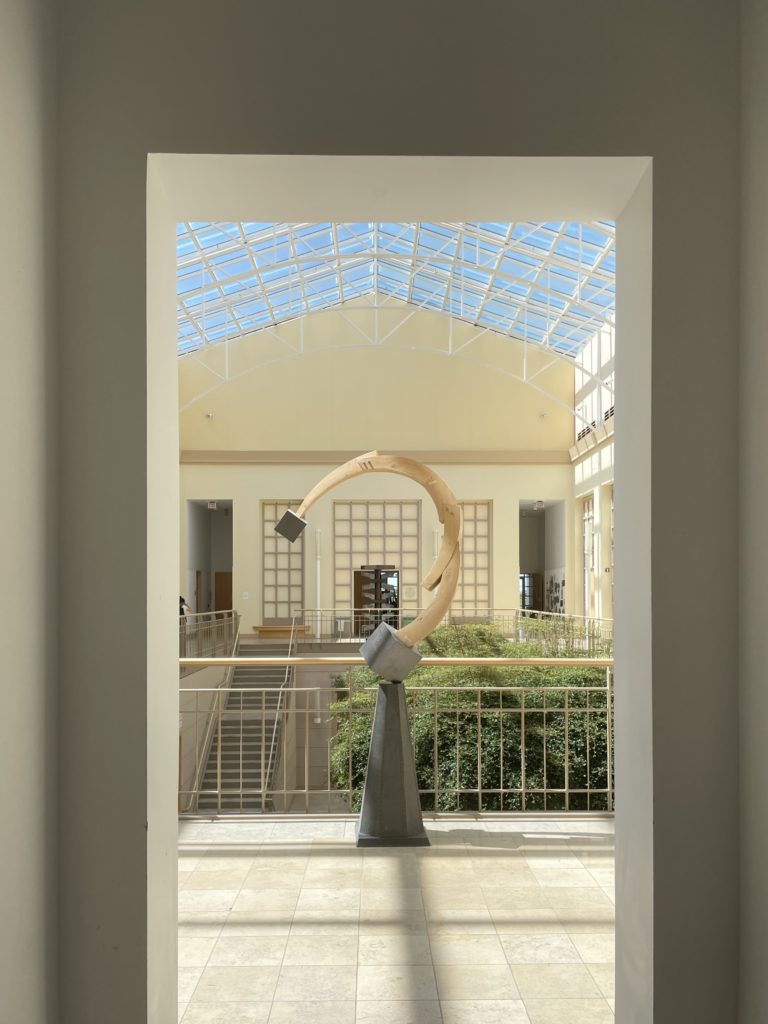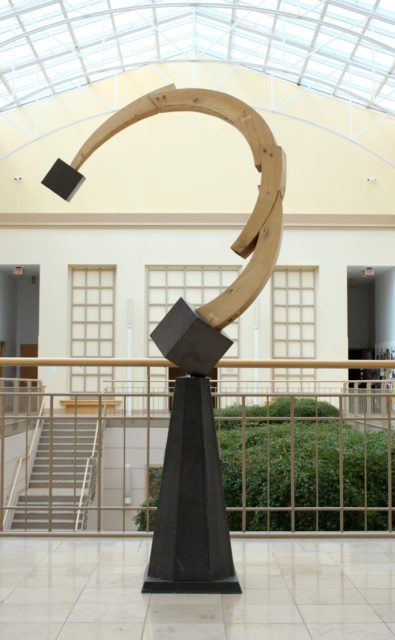Terrence Karpowicz (American, b. 1948)
Hurra Dura, 1993
Oak, cherry, lead, graphite
Gift of Daniel Schneider
Two years ago I first stepped into the Visual Arts Center, or what we call the “VAC.” From then on the lounge on the 2nd floor of this building became my favorite place on campus. Part of the reason why I love the space is that from there, I get to appreciate the sculpture Hurra Dura by Terrence Karpowicz. Standing at the end of the hallway, its wooden curve reflects the sunshine pouring from the glass dome of the atrium. The wood and stone give it a sense of primitive and organic beauty, yet the combination of sharp edges and geometric forms mark the craftsmanship of a modern human creation.

In his statement for the Wynn Newhouse Awards, the artist described his work as self-portraiture. His aesthetics result from a fusion of his life experiences. Since his accident, Karpowicz has both witnessed and experienced the evolution of prosthetic legs: from passive legs that can be difficult to use for complex tasks like climbing stairs, to powered systems that attempt to mimic the dynamic activity of an intact knee and ankle. Through the process of refining his materials and joining them together, Hurra Dura copes with the experience of losing his limb and assimilating this loss into his daily life.
“My ability to express myself and to become enveloped in my art enabled me to achieve a symbiotic state with my disability and its expression within my art.”
It’s hard not be attracted by the sculpture’s graceful gesture and not be touched by its profound relationship with the artist. Every time I look at the sculpture, I cannot help but find myself fascinated by its almost perfect balance, a unique balance between natural and artificial, between organic and geometric, between kinesis and static. Its gorgeous curves carry such a strong momentum that reminds me of the way a whale plunges into the deep water and meteorite flies across the sky. But the balance keeps the sculpture in place so that it stands firmly and quietly at the end of the hallway. Despite all of its magnificence, it also bears gaps where two pieces of materials are joined together. These gaps remind me that the sculpture is built by a human, a man with imperfections and vulnerability. Hurra Dura not only represents our innate wonders towards nature and our most original yearnings towards freedom, both at the cores that define our existence, but also embodies a symbiotic relationship between human beings and the world of nature
Terrence Karpowicz was born in 1948 in Cleveland, Ohio and received a B.A. in fine arts from Albion College, Michigan and a graduate degree in sculpture at University of Illinois, Champaign-Urbana. After a distinguished graduate study that included several exhibitions (Frank Logan Medal and Prize from the Art Institute of Chicago) Karpowicz was awarded a Fulbright-Hayes Fellowship to the United Kingdom, serving as Scholar to the Wind and Watermill Section of the Society for the Protection of Ancient Buildings, to study the technical and mechanical aspects of the country’s medieval wind and watermills. He continued his career as a sculptor after completing his in 1976. He has exhibited throughout the United States, Mexico, Europe and in the Soviet Union. Karpowicz has received seven commissions for public sculpture from the State of Illinois and his work is held in collections of the City of Chicago, Oklahoma City, and the U.S. General Services Administration.
– Sarah Zhang, ’23

